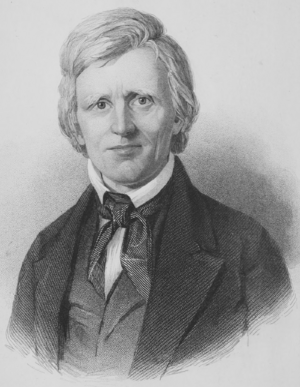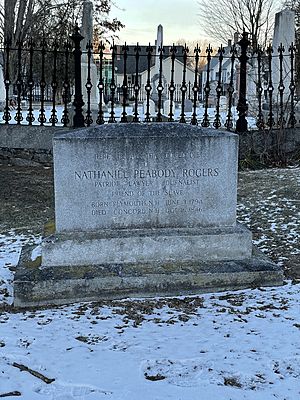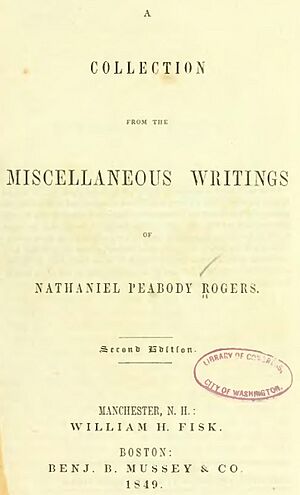Nathaniel Peabody Rogers facts for kids
Quick facts for kids
Nathaniel Peabody Rogers
|
|
|---|---|

Engraving by F. Halpin, from an original drawing by H. B. Brown
|
|
| Born | June 3, 1794 Plymouth, New Hampshire, U.S.
|
| Died | October 16, 1846 (aged 52) Concord, New Hampshire, U.S.
|
| Resting place | Old North Cemetery, Concord, New Hampshire, U.S. |
| Education | Dartmouth College |
| Occupation |
|
| Spouse(s) |
Mary Porter Farrand
(m. 1822) |
| Children | 8 |
| Signature | |
Nathaniel Peabody Rogers (born June 3, 1794 – died October 16, 1846) was an American lawyer who became a strong voice against slavery. He was also a writer and editor. From 1838 to 1846, he edited the Herald of Freedom, an important anti-slavery newspaper in New England. Rogers also worked hard for other important causes like the temperance movement (which aimed to reduce alcohol use), women's rights, and even animal rights.
Contents
Nathaniel Rogers's Early Life
Nathaniel Peabody Rogers was born in Plymouth, New Hampshire. He was the fifth child of John Rogers, a doctor and poet, and Betsy Mulliken. Young Nathaniel started college at Dartmouth College in 1811. However, he got a serious injury while playing football. This forced him to leave college for a year to get better. The injury caused him pain for the rest of his life.
Rogers returned to Dartmouth and graduated in 1816. He then studied law with Richard Fletcher, a lawyer from Salisbury, New Hampshire. In 1819, he became a lawyer in New Hampshire. In 1822, he married Mary Porter Farrand, and they had eight children together.
Fighting for Freedom and Equality
In 1838, Rogers stopped being a lawyer. He moved to Concord, New Hampshire, and became the editor of the Herald of Freedom newspaper. He had been writing articles for this anti-slavery newspaper since it started in 1835. His writings were known for being witty and sometimes sarcastic. He also wrote beautiful descriptions of nature. His articles were often printed in other anti-slavery newspapers, and he used the pen name "The Old Man of the Mountain."
In 1840, Rogers went to London to represent New Hampshire abolitionists at the World Anti-Slavery Convention. This was a big meeting about ending slavery. However, he left the meeting in protest. He did this because the convention would not let American women delegates join. When he returned to America, many people praised him for supporting equal rights for women and people of color. He became a well-known public speaker. He spoke about ending slavery, supporting women's rights, and the temperance movement.
The famous writer Henry David Thoreau even wrote an essay about Rogers in 1844. It was called "Herald of Freedom".
Nathaniel Rogers's Later Years
Nathaniel Rogers died at his home in Concord in October 1846. He is buried in Concord's Old North Cemetery. His tombstone has a special message: "Here lies all that could die of Nathaniel Peabody Rogers, patriot, lawyer, journalist, friend of the slave."
Standing Up for Animal Rights
Rogers was one of the first people to speak up for animal rights. He believed that animals also have rights. He wrote about this idea, saying:
What makes humans have rights? It's because respecting those rights makes them happy and not respecting them causes pain. A person has a right to be free. This makes them happy. So, it's their right. And every living thing that can feel joy or pain has its rights. Fair-minded people will respect these rights. And they will respect them as rights.



